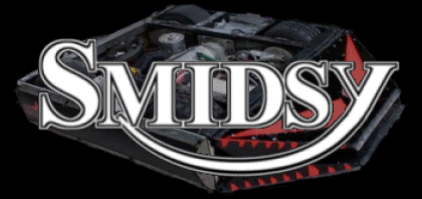About the original SMIDSY's design.
As 1998 drew to a close, a bunch of about twenty motorcyclists who are among the subscribers of a mailing list for UK bikers called IXION started talking about the Robot Wars series which was airing on BBC TV at the time. Motorcyclists are by nature people who build and modify machines, so it was only a matter of time before a heated discussion about the design shortcomings of the on-screen robots threw up the question - "Why don't we have a go at Robot Wars ourselves?". Like I said, it all seemed like such a good idea at the time.
After a lot of heated email discussions and a meeting in a rather good pub in Oxford, we all threw £20 into the kitty to give ourselves a fighting fund and set to designing our robot…
The first stage was to identify the dangers faced by a Robot Wars robot. We came up with something like this -
- The robot can be out-manoeuvred. Our robot would have to be fast, manoeuvrable, easy to drive and have plenty of traction.
- The robot can be damaged by other robots, the house robots and the arena itself. Our robot would have to be a compact design, armoured against piercing and cutting weapons, flame-proof and be constructed throughout in a manner resistant to shock and vibration.
- The robot can be disabled by other robots, the house robots or the arena obstacles. We had all seen TV footage of robots on their backs or grounded on obstacles, sitting ducks for being pushed into the pit. Our robot would have to be heavily armoured, able to run inverted and have sufficient ground clearance to negotiate debris on the arena floor.
Early ideas ranged from very practical wheeled designs through to way-out twin roller designs, but gradually an invertible rectangular 'bot, either with tracks like a WW1 tank or else with wheels spanning the height of the body, emerged. More than one tracked robot met its end on TV by having its tracks cut with pincers at the time so the basic shape of the robot was accepted as a rectangular invertible 4 wheeled 'bot. SMIDSY was born!
For the manoeuvrability required by RobotWars, car type steering is simply not suitable. The turning circles might in some cases be larger than the arena itself. For this reason most if not all 'bots in the competition opt for differential steering as used in Caterpillar tractors and the like. The 'bot is turned by varying the power delivered to the wheels on either side. Our design therefore needed two separate controllable power sources. We had already discounted internal combustion engines as presenting too many design problems, so power had to come from two electric motor systems.
Having decided on electric power, our next problem came from the transmission. Electric motors turn a lot faster than the wheels on a Robot Wars 'bot, so some kind of speed reduction system, belts or gears would be required. These would take up a lot of space in our robot, and be a challenge to manufacture. A very elegant solution came from the team member who was later to be the mechanic in our TV show team, Andy Pugh. His idea was to use the in-hub gearboxes as used on some bicycles; these are compact, robust and reliable units designed for many miles of hard labour on the road, so well suited to RobotWars.
So in early 1999, SMIDSY took shape in Andy's workshop. The chassis is made of folded sheet steel welded together in a very rigid box section, the side armour is machined from polypropylene gas pipeline and the top and bottom armour is thick sheet aluminium. Gas pipeline is designed not to leak gas if errant builders hit it with their diggers - we felt it would be well up to RobotWars. The curved sides also meant that SMIDSY couldn't be stranded by being balanced on its side. A set of kart wheels begged from a friendly karting arena and fitted with slick tyres completed the picture.
We now had a robot, or at least the shell of one. Into that we put two powerful Bosch 24V motors, 4QD electronic speed controllers and a large number of Cyclon lead-acid gel-cells. A forced air cooling system followed, and a large area of stainless steel gauze to stop flames finding their way into the 'bot.
I haven't mentioned weapons, have I? A lot of teams spend a lot of time and money on finely crafted weapons which are either ineffectual or need to be aimed to within microns of their target to be of any use. Indeed, with a very few notable exceptions, most Robot Wars bouts are won on manoeuvrability rather than weapons engineering. We therefore went for a low-tech approach to weapons design once we had a 'bot worthy of taking a weapon.
SMIDSY's Gnashing Jaws of Doom are a large set of hinged jaws on the front of the robot. They are operated by a pair of Jaguar electric seat adjusters. Systems capable of moving fatcat businessmen in their cars proved strong enough to crush tin cans when fitted to a robot! The main purpose of the GJOD is not as jaws though. We hoped they would double as wedge and flipper in the arena, and in fact they were proved to be of reliable design.
So there we were, with a robot, a team, and a ticket to Borehamwood for the filming.
Summer '99 had been a lot of fun building SMIDSY, and rain outside the studio couldn't dampen our spirits! What happened next? Find out here…

